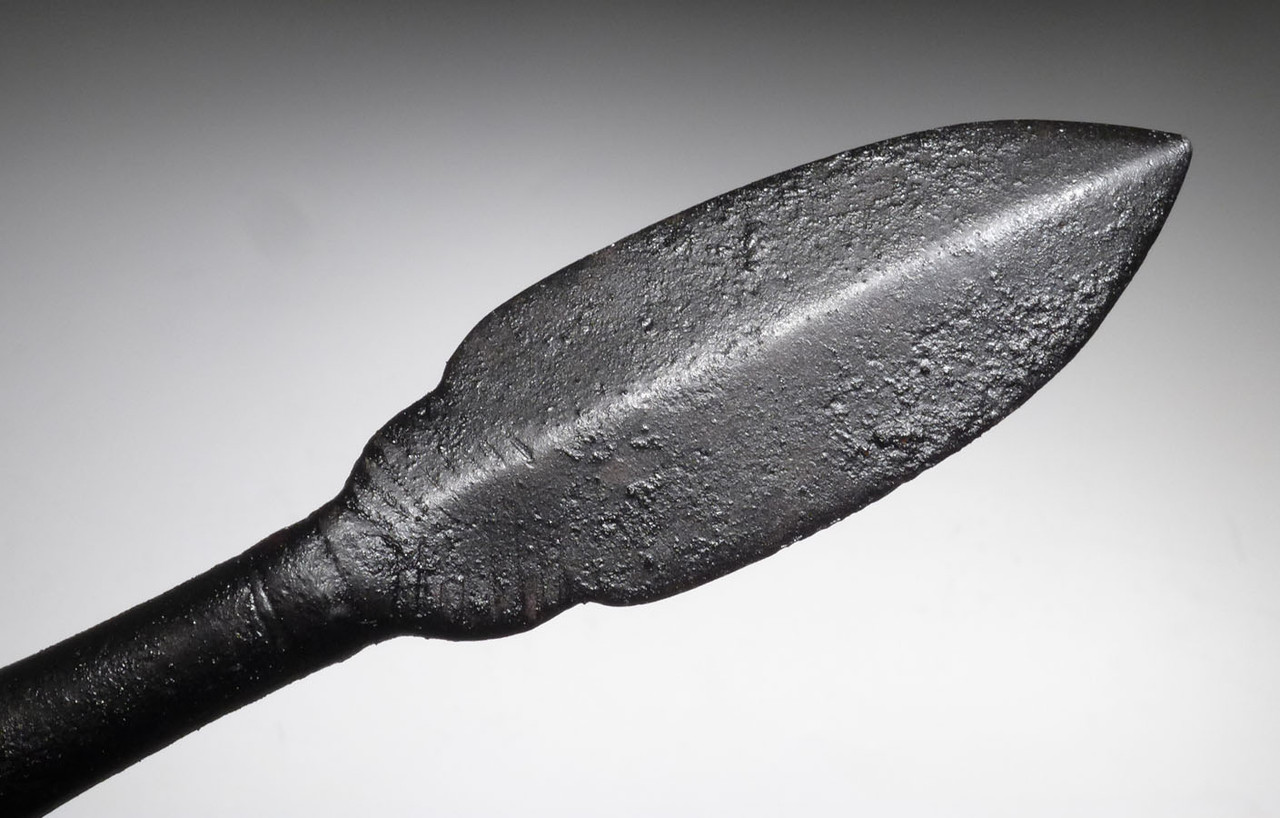Product Description
SEE MORE ANCIENT NEAR EASTERN ARTIFACTS
SEE MORE ANCIENT ROMAN ARTIFACTS
This exceptional ancient throwing javelin spearhead is from the early Islamic enemy of the Roman Byzantine Empire, the Umayyads. It could have been carried by either a mounted horse soldier or, an infantry foot soldier. Weapons of the Umayyad caliphate are RARE and should have a place in every ancient weapon collection, as their part of history is unique, as well as important. The Illuminated Manuscripts with their famous Miniatures (small illustrations and paintings), explicitly illustrate the weapons used of these days. The artwork has been invaluable in documenting all forms of dress, tactics and militaria. Weapons such as the genuine example offered here, can be seen in these important ancient texts.
This is a RARE opportunity to acquire an exquisitely preserved decorated iron war spearhead from the Umayyad Caliphate. The spear head is complete with a full socketed shaft featuring engraved decoration. The blade and shaft body are intact as originally made and the entire spearhead is complete, rare for iron weapons of this period. Tip and cutting edges are still sharp. A fine and impressive primary weapon from this famous empire and culture.
HISTORY
The Umayyad Caliphate (also Omayyad), was the second of the four major caliphates established after the death of Muhammad. The caliphate was ruled by the Umayyad dynasty hailing from Mecca. A Umayyad clan member had previously come to power as the third Rashidun Caliph, Uthman ibn Affan (r. 644–656), but official Umayyad rule was established by Muawiya ibn Abi Sufyan, long-time governor of Syria, after the end of the First Muslim Civil War in AD 661. Syria remained the Umayyads' main power base thereafter, and Damascus was their capital.
The Umayyads continued the Muslim conquests, incorporating the Transoxiana, Sindh, the Maghreb and the Iberian Peninsula (Al-Andalus) into the Muslim world. At its greatest extent, the Umayyad Caliphate covered 11,100,000 km2 (4,300,000 sq mi) and 62 million people (29% of the world's population), making it one of the largest empires in history in both area and proportion of the world's population.
The Umayyad Caliphate was de facto secular. At the time, the Umayyad taxation and administrative practice were perceived as unjust by some Muslims. The Christian and Jewish population still had autonomy; their judicial matters were dealt with in accordance with their own laws and by their own religious heads or their appointees, although they did pay a poll tax (the jizya) for protection to the central state. Muhammad had stated explicitly during his lifetime that Abrahamic religious groups (still a majority in times of the Umayyad Caliphate) should be allowed to practice their own religion, provided that they paid the jizya taxation. The welfare state of both the Muslim and the non-Muslim poor started by Umar ibn al Khattab had also continued, financed by the Zakat tax levied only on Muslims.
Muawiya's wife Maysum (Yazid's mother) was also a Christian. The relations between the Muslims and the Christians in the state were stable in this time. The Umayyads were involved in frequent battles with the Christian Byzantines without being concerned with protecting themselves in Syria, which had remained largely Christian like many other parts of the empire. Prominent positions were held by Christians, some of whom belonged to families that had served in Byzantine governments. The employment of Christians was part of a broader policy of religious assimilation that was necessitated by the presence of large Christian populations in the conquered provinces, as in Syria. This policy also boosted Muawiya's popularity and solidified Syria as his power base.
During the period of the Umayyads, Arabic became the administrative language. State documents and currency were issued in the language. Mass conversions brought a large influx of Muslims to the caliphate. The Umayyads also constructed famous buildings such as the Dome of the Rock at Jerusalem, and the Umayyad Mosque at Damascus.
The Muslim Arabs were at the top of the society and saw it as their duty to rule over the conquered areas. Despite the fact that Islam teaches the equality of all Muslims, the Arab Muslims held themselves in higher esteem than Muslim non-Arabs and generally did not mix with other Muslims. The inequality of Muslims in the empire led to social unrest. As Islam spread, more and more of the Muslim population was constituted of non-Arabs. This caused tension as the new converts were not given the same rights as Muslim Arabs. Also, as conversions increased, tax revenues from non-Muslims decreased to dangerous lows. These issues continued to grow until they helped cause the Abbasid Revolt in the 740s which brought an end to the Umayyad dynasty.
WARNING: There is a number of fake and misidentified ancient weapons on the market. As fine quality intact, original specimens become more scarce and techniques have become more sophisticated to fake these weapons. We inspect, clean and conserve in our lab every specimen we offer for sale. Our extensive experience with handling thousands of pieces from museum and private collections has afforded us rare and invaluable experience with authentic specimens as well as convincing forgeries. The degree to which the fakers have been able to replicate patina to disguise their work requires an expert examination by highly experienced individuals. It is common to find very reasonably priced weapons that are made up of part original and part modern components or wholly modern pieces displaying elaborate artificial patinas. All purchases should include from the dealer a written guarantee of authenticity with unconditional and lifetime return policies regarding such guarantee.
 US DOLLAR
US DOLLAR
 EURO
EURO
 AUSTRALIAN DOLLAR
AUSTRALIAN DOLLAR
 CANADIAN DOLLAR
CANADIAN DOLLAR
 POUND STERLING
POUND STERLING










